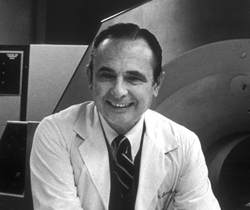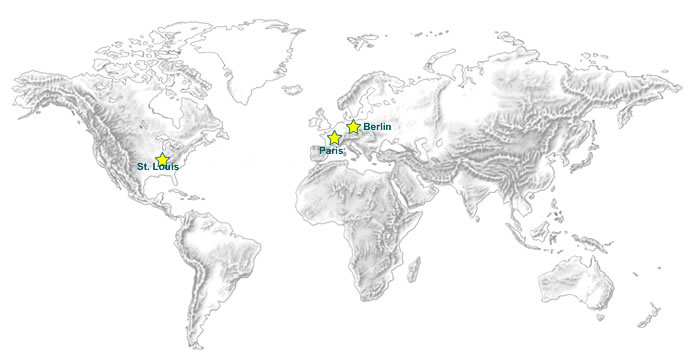Michel M. Ter-Pogossian (1925-1996)
 |
| Michel M. Ter-Pogossian |
| (Photo courtesy Mallinckrodt Institute of Radiology at Washington University School of Medicine) |
Born on April 21, 1925, in Berlin, Michel Ter-Pogossian was the only child of Armenian parents who had settled in Germany after escaping ethnic persecution in their homeland following World War I. The family moved to France when Michel was a young child. His fascination with science began as a youngster and was fueled by experiments involving his toy physics and chemistry kits. He later earned degrees in science from the University of Paris and from the Institute of Radium in 1943 and 1946, respectively. It was in 1946 that Ter-Pogossian came to the United States to further his education, an outgrowth of his father’s concern about young Michel’s involvement with the war resistance efforts in France.
Ter-Pogossian was drawn to Washington University in large part by the reputation of Arthur Holly Compton, a physicist and a Nobel laureate, who was the university’s chancellor. In 1946, while studying for his degree, Ter-Pogossian worked in the Department of Physics as a research assistant. He received a master’s degree in 1948 and a doctoral degree in nuclear physics in 1950. He joined the faculty of Mallinckrodt Institute in 1950 and was appointed as professor of radiation sciences in 1961. He also held a joint appointment as professor of biophysics in physiology. In 1973, he was named head of Mallinckrodt Institute’s Division of Radiation Sciences, but the self-professed “research junkie” missed devoting his full time to laboratory work. In 1990, he stepped down from his administrative duties to return to his first love: research. Ter-Pogossian assumed emeritus status in 1995. The following year, while visiting Paris, he died suddenly of a heart attack.
Among his many accomplishments, Michel Ter-Pogossian will foremost be remembered as the “father of PET.” In the early 1970s, he led a collaborative research team of physical scientists, chemists, and physicians who developed the concept of positron emission tomography (PET). A major contribution, PET displays actual metabolic activity within different regions of organs and tissues, thereby extending scientists’ and physicians’ understanding of basic biological processes and providing a basis for the improved diagnosis of diseases. He played a major role in developing the concept of short-lived isotopes and in designing and constructing the first PET scanner as well as the first multislice and the first time-of-flight PET scanners.
During a career that spanned more than four decades, he earned numerous accolades for his achievements in nuclear science, including France’s Gold Medal Award of the Société Francaise de Médecine Nucléaire et de Biophysique, Canada’s prestigious Gairdner Award, St. Louis’ Peter H. Raven Lifetime Award of the Academy of Sciences, as well as the Society of Nuclear Medicine’s Georg Charles de Hevesy Nuclear Medicine Pioneer Award and the Paul C. Aebersold Award. Ter-Pogossian was a member of many professional societies. He was elected in 1987 to the Institute of Medicine and served on the editorial boards of major scientific journals, including the American Journal of Roentgenology, the Journal of Nuclear Medicine, and the Journal de Biophysique & Médecine Nucléaire.
Dr. Ter-Pogossian was a prolific author, with more than 250 papers and book chapters to his credit, and was a charter member of the American Nuclear Society and a fellow of the American Physical Society. In addition, he was a past trustee of the Academy of Sciences of St. Louis and served as an advisor for several Department of Energy and National Institutes of Health committees.

Related Resources:
Back to Biographies
